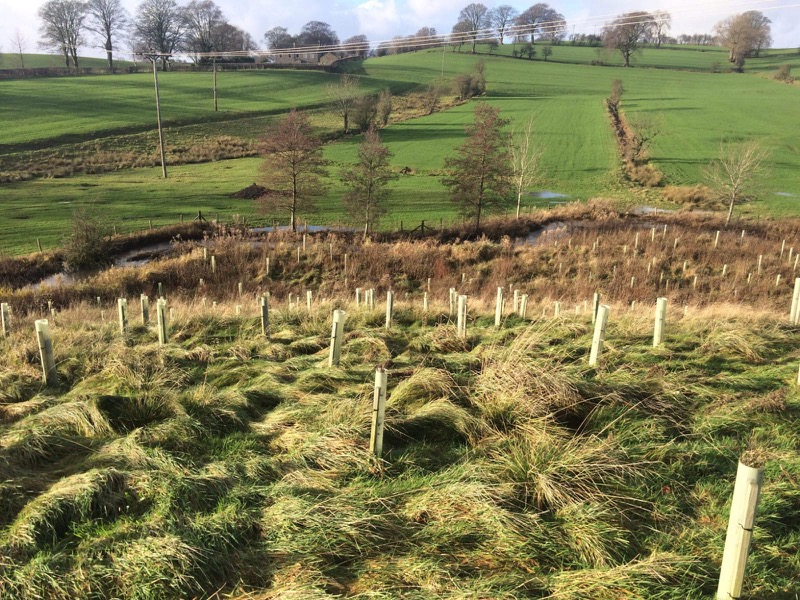This blog has been written by The Flood Hub People.
Natural Flood Management (NFM) is more than just a way to reduce flood risk, it offers multiple benefits for the environment, society, and communities. By working with natural processes, NFM measures not only manage floodwater but also improve biodiversity, water quality, soil health, agricultural productivity and community resilience.
This blog explores the many advantages of NFM and how it can make our landscapes more sustainable and resilient.
Natural Flood Management (NFM) uses natural processes and landscapes to reduce the risk of flooding. Instead of relying solely on hard engineering like walls or dams, NFM works with rivers, wetlands, woodlands, soils and coastal areas to slow, store, and manage water naturally. Common measures include wetland restoration, woodland creation, river re-meandering, offline storage and sustainable agricultural practices.
By integrating these measures, NFM not only helps reduce flood risk but also supports biodiversity, improves water quality, protects soil, and creates more resilient landscapes.
For more information and case studies, read our dedicated Natural Flood Management page here.
Wetlands are one of the most biologically diverse ecosystems due to high nutrient levels and primary productivity. Not only do wetlands provides further flood storage capacity within the catchment, but they also improve biodiversity, create habitats and improve connectivity between wetlands allowing more species to move amongst habitats.
Woodland creation helps to manage flood risk by improving infiltration whilst also providing an important wildlife habitat, encouraging the development of a wide range of species and increases shade and shelter beneath the tree canopy.
Many NFM measures simultaneously improve water quality whilst managing flood risk, which in turn has the potential to improve in stream habitats for wildlife.

Image: The Flood Hub
Improved water quality and reduced soil erosion are two benefits of NFM measures that are closely linked. For example, improving soil structure through woodland creation or less intensive land management increases infiltration rates and reduces run off. This in turn reduces soil erosion and improves water quality as less soil, nutrients and chemicals are being lost in run off.
Reconnecting wetlands helps to manage high nutrient loads and reduce the amount of sediment that is suspended in the water, contributing to improvements in water quality.
In addition, coastal NFM measures can help to restore coastal sediment processes and coastal morphology. Salt marshes and mudflats help to reduce wave energy at shorelines, sand dunes act as a natural buffer for cliffs from waves and beach nourishment restores the natural coastal defence function of beaches, all helping to reduce coastal erosion and in turn manage flood risk.
Measures such as run off pathway management and offline storage areas can help with sediment capture, preventing soil erosion and loss of sediments and fertilisers into the watercourse. Agricultural NFM can improve soil structure, reduce loss of top soil and increase soil productivity, which can in turn increase agricultural productivity.
Increased productivity is also advantageous for the landowner as they will be getting more from their land!
The Countryside Stewardship Scheme has a range of grants for farmers and land managers who wish to adopt NFM techniques. These can be capital items or management options, for example in stream structures or river bank restoration. Facilitation funds may be available in your area to assist with your application and provide a 20% uplift to your score.
More information on funding can be found on our ‘Landowner’ page here.
Making small adjustments to your land management or allowing unproductive land to be used for measures such as flood storage, can make a difference to those in your community who are at risk of flooding further downstream, particularly if several landowners work together to implement NFM measures.
Developing green spaces using NFM measures can also have massive social benefits through providing better access to green spaces, improving the environment we live in and improving quality of life.
Wetlands and woodlands are efficient at accumulating and storing carbon and removing carbon dioxide from the atmosphere. Therefore, by creating more of them, you are increasing the capacity of the environment to store carbon and creating ecosystems that are more resilient to climate change. Measures that reduce surface run off and soil erosion such as contour cultivation can also reduce carbon loss from soil.
Whether your interests are biodiversity, improving water quality or reducing erosion, by putting NFM measures in place you are potentially not only helping to manage flood risk but also providing more diverse ecosystems, reducing siltation and increasing the productivity of your land in turn to create a better environment for you and your community.
Click here for a downloadable resource on the multiple benefits of NFM.
We also have a whole section dedicated to the multiple benefits on our NFM page here.